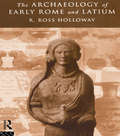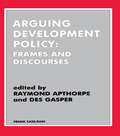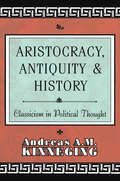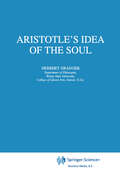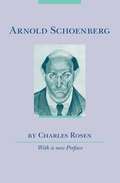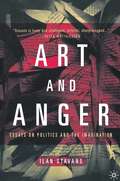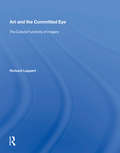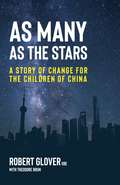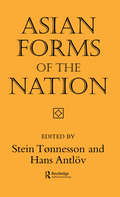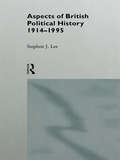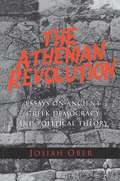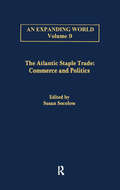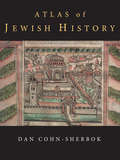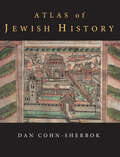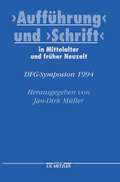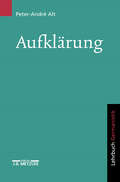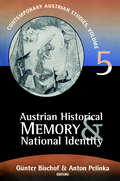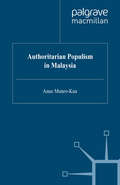- Table View
- List View
The Archaeology of Early Rome and Latium
by Ross R. HollowayThe archaeology of early Rome has progressed rapidly and dramatically over the last century; most recently with the discovery of the shrine of Aeneas at Lavinium and the reports of the walls of the Romulan city discovered on the city slopes of the Palatine Hill. The Archaeology of Early Rome and Latium presents the most recent discoveries in Rome and its surroundings: princely tombs,inscriptions and patrician houses are included in a complete overview of the subject and the controversies surrounding it.This comprehensively illustrated study fills the need for an accessible English guide to these new discoveries, and in preparation, the author interviewed most of the leading figures in current research on the early periods of Rome.
Arguing Development Policy: Frames and Discourses
by Raymond Apthorpe Des GasperThis collection shows how policy discourses in the fields of national and international developments are constructed and operate and how they can be analysed. Dominant discourses screen out certain aspects: they frame' issues to include some matters and typically exclude important others. More generally, different policy discourses construct the world in distinctive ways, through language that requires deconstruction and careful review.
Arguing Development Policy: Frames and Discourses
by Raymond Apthorpe Des GasperThis collection shows how policy discourses in the fields of national and international developments are constructed and operate and how they can be analysed. Dominant discourses screen out certain aspects: they frame' issues to include some matters and typically exclude important others. More generally, different policy discourses construct the world in distinctive ways, through language that requires deconstruction and careful review.
Aristocracy, Antiquity and History: Classicism in Political Thought
by Andreas KinnegingThis brilliant critique of the literature on modernity challenges conventional approaches in two fundamental ways: First, the lineage of the modern turns out to be less ancient and glorious than is usually suggested. Modernity is an upstart rather than a scion of an old and celebrated line. The roots of modernity are held to be less secure than previously thought. This leads the author to suggest that the demise of the old is a matter of rhetoric rather than reality. The old was driven underground rather than extinguished. The inherited traditions are deeply embedded in our souls. We turn to modernity as a half-baked worldview to overcome our estrangement from the past.Kinneging examines this sweeping view in the concrete circumstances of the imagined fall of the aristocracy and rise of the enterprising bourgeoisie. But aristocracy, this study reveals a strong and thriving noblesse, not only in places like Russia and Prussia, but also in advanced capitalist states like France and England. Aristocracy, Antiquity, and History shows conclusively that the actual demise of this exploration into the sources of Western thought takes seriously the strength of an aristocratic vision that lives on in a variety of conservative and liberal doctrines.In Aristocracy, Antiquity and History the readers is reacquainted with the democratic potential as in the work of Montesquieu, and the way in which classicism, romanticism, and modernism, far from a sequential set of events, are entwined in the ethic of honor and in the moral order of modern life. In trying to understand modernity, advanced societies cannot help but draw attention to the old by way of contrast. The presence of antiquity, however suppressed or shrugged off, does not disappear, but stays with us in the very act of rebellion against the ancients. This fine work in the history of ideas will serve to redefine and redirect researches in social and political theory for years to come.
Aristocracy, Antiquity and History: Classicism in Political Thought
by Andreas KinnegingThis brilliant critique of the literature on modernity challenges conventional approaches in two fundamental ways: First, the lineage of the modern turns out to be less ancient and glorious than is usually suggested. Modernity is an upstart rather than a scion of an old and celebrated line. The roots of modernity are held to be less secure than previously thought. This leads the author to suggest that the demise of the old is a matter of rhetoric rather than reality. The old was driven underground rather than extinguished. The inherited traditions are deeply embedded in our souls. We turn to modernity as a half-baked worldview to overcome our estrangement from the past.Kinneging examines this sweeping view in the concrete circumstances of the imagined fall of the aristocracy and rise of the enterprising bourgeoisie. But aristocracy, this study reveals a strong and thriving noblesse, not only in places like Russia and Prussia, but also in advanced capitalist states like France and England. Aristocracy, Antiquity, and History shows conclusively that the actual demise of this exploration into the sources of Western thought takes seriously the strength of an aristocratic vision that lives on in a variety of conservative and liberal doctrines.In Aristocracy, Antiquity and History the readers is reacquainted with the democratic potential as in the work of Montesquieu, and the way in which classicism, romanticism, and modernism, far from a sequential set of events, are entwined in the ethic of honor and in the moral order of modern life. In trying to understand modernity, advanced societies cannot help but draw attention to the old by way of contrast. The presence of antiquity, however suppressed or shrugged off, does not disappear, but stays with us in the very act of rebellion against the ancients. This fine work in the history of ideas will serve to redefine and redirect researches in social and political theory for years to come.
Aristotle’s Idea of the Soul (Philosophical Studies Series #68)
by H. GrangerAristotle's Idea of the Soul considers the nature of the soul within Aristotle's psychology and natural philosophy. A survey is provided of the contemporary interpretations of Aristotle's idea of the soul, which are prominent in the Aristotelian scholarship within the analytic tradition. These interpretations are divided into two positions: `attributivism', which considers the soul to be a property; and `substantialism', which considers it to be a thing. Taxonomies are developed for attributivism and substantialism, and the cases for each of them are considered. It is concluded that neither position may be maintained without compromise, since Aristotle ascribes to the soul features that belong exclusively to a thing and exclusively to a property. Aristotle treats the soul as a `property-thing', as a cross between a thing and a property. It is argued that Aristotle comes by this idea of the soul because his hylomorphism casts the soul as a property and his causal doctrine presents it as a causal agent and thereby as a thing.
Arnold Schoenberg (Princeton Legacy Library)
by Charles RosenIn this lucid, revealing book, award-winning pianist and scholar Charles Rosen sheds light on the elusive music of Arnold Schoenberg and his challenge to conventional musical forms. Rosen argues that Schoenberg's music, with its atonality and dissonance, possesses a rare balance of form and emotion, making it, according to Rosen, "the most expressive music ever written." Concise and accessible, this book will appeal to fans, non-fans, and scholars of Schoenberg, and to those who have yet to be introduced to the works of one of the greatest composers of the twentieth century. "Arnold Schoenberg is one of the most brilliant monographs ever to be published on any composer, let alone the most difficult master of the present age. . . . Indispensable to anyone seeking to understand the crucial musical ideas of the first three decades."—Robert Craft, New York Review of Books "What Mr. Rosen does far better than one could reasonably expect in so concise a book is not only elucidate Schoenberg's composing techniques and artistic philosophy but to place them in history."—Donal Henahan, New York Times Book Review "For the novice and the knowledgeable, Mr. Rosen's book is very important reading, either as an introduction to the master or as a stimulus to rethinking our opinions of him. Mr. Rosen's accomplishment is enviable."—Joel Sachs, Musical Quarterly
Art and Anger: Essays on Politics and the Imagination
by I. StavansFascinated by the idea of Western civilization as being a sequence of numerous misinterpretations and misrepresentations, these nineteen essays cover a broad range of topics with the unifying theme being the crossroads where politics and the imagination meet. An essay on linguistics and culture discusses the shaping of Latin America's collective identity; Peru's modern history is approached as a bloody battle between enlightenment and darkness; and in critiques of Octavio Paz and Gabriel García Márquez, Stavans reflects on the dichotomy between pen and sword in the Hispanic world. In 'Letter to a German Friend', Stavans returns to his fate as a Jew in the Southern Hemisphere, and in 'The First Book,' he connects his passion for literature to his initiation into Jewishness. Finally, in a meditation on Columbus's afterlife, he reflects on the many ways in which we reinvent ourselves in order to make sense of the chaotic world that surrounds us.
Art And The Committed Eye: The Cultural Functions Of Imagery
by Richard LeppertIn Art and the Committed Eye Richard Leppert examines Western European and American art from the fifteenth to the twentieth century. He studies the complex relation between the "look" of images and the variety of social and cultural uses to which they are put and demonstrates that the meaning of any image is significantly determined by its function, which changes over time. In particular, he emphasizes the ways in which visual culture is called on to mediate social differences defined by gender, class, and race. In , Leppert addresses the nature and task of representation, discussing how meaning accrues to images and what role vision and visuality play in the history of modernity. Here he explains imagery's power to attract our gaze by triggering desire and focuses on the long history of the use of representation to enact a deception, whether in painting or advertising. explores art's relation to the material world, to the ways in which images mark our various physical and psychic ties to objects. The author analyzes still life paintings whose subject matter is both extraordinarily diverse and deeply paradoxical—from flower bouquets to grotesque formal arrangements of human body parts. Leppert demonstrates that even in "innocent" still lifes, formal design and technical execution are imbued with cultural conflict and social power. is devoted to the representation of the human body—as subject to obsessive gazing and as an object of display, spectacle, and transgression. The variety of body representation is enormous: pleased or tortured, gorgeous or monstrous, modest or lascivious, powerful or weak, in the bloom of life or under the anatomist's knife, clothed or naked. But it is the sexual body, Leppert shows, that has provided the West with its richest, most complex, contradictory, conflicted, and paradoxical accounts of human identity in relation to social ideals.
Art And The Committed Eye: The Cultural Functions Of Imagery
by Richard LeppertIn Art and the Committed Eye Richard Leppert examines Western European and American art from the fifteenth to the twentieth century. He studies the complex relation between the "look" of images and the variety of social and cultural uses to which they are put and demonstrates that the meaning of any image is significantly determined by its function, which changes over time. In particular, he emphasizes the ways in which visual culture is called on to mediate social differences defined by gender, class, and race. In , Leppert addresses the nature and task of representation, discussing how meaning accrues to images and what role vision and visuality play in the history of modernity. Here he explains imagery's power to attract our gaze by triggering desire and focuses on the long history of the use of representation to enact a deception, whether in painting or advertising. explores art's relation to the material world, to the ways in which images mark our various physical and psychic ties to objects. The author analyzes still life paintings whose subject matter is both extraordinarily diverse and deeply paradoxical—from flower bouquets to grotesque formal arrangements of human body parts. Leppert demonstrates that even in "innocent" still lifes, formal design and technical execution are imbued with cultural conflict and social power. is devoted to the representation of the human body—as subject to obsessive gazing and as an object of display, spectacle, and transgression. The variety of body representation is enormous: pleased or tortured, gorgeous or monstrous, modest or lascivious, powerful or weak, in the bloom of life or under the anatomist's knife, clothed or naked. But it is the sexual body, Leppert shows, that has provided the West with its richest, most complex, contradictory, conflicted, and paradoxical accounts of human identity in relation to social ideals.
As Many as the Stars
by Robert Glover'There are a few rare occasions in life, when events seem to conspire in a profound and extraordinary way. In those moments God pulls back the curtain on his plans and you get to see a glimpse of what he has in store in you. In the end you are clearer on your life's purpose and destiny. This was one of those moments.'AS MANY AS THE STARS tells the story of how one man moved with his wife and six young children from the UK to China to follow God's call. Robert Glover was a social worker in the East of England who went on to radically transform Chinese government's policy on care welfare. In conversations with the Chinese government Robert fought to show that family-based fostering and adoption was a better alternative to the system of state-sponsored orphanages. In 1998, Robert pioneered the first small pilot project in Shanghai. In the same year Care for Children was founded as a charity as the first joint venture social welfare project between the British and Chinese governments. The goal was to provide skills and knowledge to local staff that could eventually impact many thousands of orphans in China. Robert had a big vision but continued to trust God in his plans. Now Robert's charity Care for Children has reached their goal of getting ONE MILLION children fostered or adopted, which is 85% of the children in the state-run institutions and they have since expanded into Thailand and Vietnam.Told with humour & simplicity AS MANY AS THE STARS gives a deeper understanding of the importance of families in God's plan; God's deep concern for the plight of the orphan and the poor; how to live with greater compassion, generosity and courage to share the love of Christ with a needy world.
Asian Forms of the Nation
by Stein Tonnesson Hans AntlovThe general tendency among theorists in nationalism and national identity has been to assume that the modernization process in Asia and Africa is a kind of distorted reflection of a Western precedent; Asian forms of the nation have rarely been seen as independent, alternative models. Among today's leading theoreticians, there is a growing tendency to take Asia seriously, and to include Asian examples in the general discussion. The aim of the present collection is to build on and reinforce this tendency. It does not postulate any specifically Asian form of the nation, as opposed to a Western one. Rather, it seeks to demonstrate that in Asia, as well as in Europe, each nation forms a unique amalgam which can be compared fruitfully with others. History, culture and geography have posed various kinds of limits to what can be imagined (as Benedict Anderson puts it). The relationship between geographical space and national construction is explored in depth here.
Asian Forms of the Nation (PDF)
by Stein Tonnesson Hans AntlovThe general tendency among theorists in nationalism and national identity has been to assume that the modernization process in Asia and Africa is a kind of distorted reflection of a Western precedent; Asian forms of the nation have rarely been seen as independent, alternative models. Among today's leading theoreticians, there is a growing tendency to take Asia seriously, and to include Asian examples in the general discussion. The aim of the present collection is to build on and reinforce this tendency. It does not postulate any specifically Asian form of the nation, as opposed to a Western one. Rather, it seeks to demonstrate that in Asia, as well as in Europe, each nation forms a unique amalgam which can be compared fruitfully with others. History, culture and geography have posed various kinds of limits to what can be imagined (as Benedict Anderson puts it). The relationship between geographical space and national construction is explored in depth here.
Aspects of British Political History 1914-1995
by Stephen J. LeeAspects of British Political History 1914-1995 examines all the major themes, personalities and issues of this important period in a clear and digestible form. It:* introduces fresh angles to long-studied topics* consolidates a great body of recent research* analyses views of different historians* offers an interpretive rather than narrative approach * gives concise treatment to complex issues* is directly relevant to student questions and courses* is carefully organised to reflect the way teachers tackle these courses* is illustrated with helpful maps, charts, illustrations and photographs.
Aspects of British Political History 1914-1995
by Stephen J. LeeAspects of British Political History 1914-1995 examines all the major themes, personalities and issues of this important period in a clear and digestible form. It:* introduces fresh angles to long-studied topics* consolidates a great body of recent research* analyses views of different historians* offers an interpretive rather than narrative approach * gives concise treatment to complex issues* is directly relevant to student questions and courses* is carefully organised to reflect the way teachers tackle these courses* is illustrated with helpful maps, charts, illustrations and photographs.
The Athenian Revolution: Essays on Ancient Greek Democracy and Political Theory
by Josiah OberWhere did "democracy" come from, and what was its original form and meaning? Here Josiah Ober shows that this "power of the people" crystallized in a revolutionary uprising by the ordinary citizens of Athens in 508-507 B.C. He then examines the consequences of the development of direct democracy for upper-and lower-class citizens, for dissident Athenian intellectuals, and for those who were denied citizenship under the new regime (women, slaves, resident foreigners), as well as for the general development of Greek history. When the citizens suddenly took power into their own hands, they changed the cultural and social landscape of Greece, thereby helping to inaugurate the Classical Era. Democracy led to fundamental adjustments in the basic structures of Athenian society, altered the forms and direction of political thinking, and sparked a series of dramatic reorientations in international relations. It quickly made Athens into the most powerful Greek city-state, but it also fatally undermined the traditional Greek rules of warfare. It stimulated the development of the Western tradition of political theorizing and encouraged a new conception of justice that has striking parallels to contemporary theories of rights. But Athenians never embraced the notions of inherency and inalienability that have placed the concept of rights at the center of modern political thought. Thus the play of power that constituted life in democratic Athens is revealed as at once strangely familiar and desperately foreign, and the values sustaining the Athenian political community as simultaneously admirable and terrifying.
The Atlantic Staple Trade: Volume 1: Commerce and Politics; Volume 2: The Economics of Trade (An\expanding World: The European Impact On World History, 1450 To 1800 Ser. #Vol. 9)
by Susan SocolowThis two volume set reprints the most important standard studies and interpretations of the development of the crucial Atlantic trade. The first volume, concerned with general trade and political economy, approaches the topic from the viewpoint of individual trading nations in the Atlantic - England, France, Ireland, Spain - whilst not neglecting the importance of regions like West Africa. Rivalry between the different national traders is also considered, as well as the vexed question of the relation of trade to the old colonial empires. The impact of administration, war and regulation as reflected by the contraband issue highlights the strong political element in the developing Atlantic commercial world. Case studies are provided of major staple and luxury commodity trades: rice, molasses, tobacco, cochineal, logwood, hides, cacao and the sometimes neglected whaling industry. These set the scene for quantitative and technical studies of the contribution of shipping to trade. Specific markets considered in more detail include a comparison of Philadelphia and Havana, the changing scale of business activity in the Chesapeake trade, and the impact of trade on port development in America. The volume closes with seminal studies by McCusker and Price on the central role of trade and the Atlantic economy. Taken together these two volumes provide the best possible foundation for the detailed study of the Atlantic trade in global expansion.
The Atlantic Staple Trade: Volume 1: Commerce and Politics; Volume 2: The Economics of Trade
by Susan SocolowThis two volume set reprints the most important standard studies and interpretations of the development of the crucial Atlantic trade. The first volume, concerned with general trade and political economy, approaches the topic from the viewpoint of individual trading nations in the Atlantic - England, France, Ireland, Spain - whilst not neglecting the importance of regions like West Africa. Rivalry between the different national traders is also considered, as well as the vexed question of the relation of trade to the old colonial empires. The impact of administration, war and regulation as reflected by the contraband issue highlights the strong political element in the developing Atlantic commercial world. Case studies are provided of major staple and luxury commodity trades: rice, molasses, tobacco, cochineal, logwood, hides, cacao and the sometimes neglected whaling industry. These set the scene for quantitative and technical studies of the contribution of shipping to trade. Specific markets considered in more detail include a comparison of Philadelphia and Havana, the changing scale of business activity in the Chesapeake trade, and the impact of trade on port development in America. The volume closes with seminal studies by McCusker and Price on the central role of trade and the Atlantic economy. Taken together these two volumes provide the best possible foundation for the detailed study of the Atlantic trade in global expansion.
Atlas of Jewish History
by Dan Cohn-SherbokIn this illuminating history, Dan Cohn-Sherbok traces the development of Jewish history from ancient times to the present day. Containing over 100 maps and 30 photographs, this is a comprehensive atlas of Jewish history designed for students and the general reader. It is ideally suited for those courses in Jewish or Biblical Studies, serving as a handy reference guide as well as a textbook.
Atlas of Jewish History
by Dan Cohn-SherbokIn this illuminating history, Dan Cohn-Sherbok traces the development of Jewish history from ancient times to the present day. Containing over 100 maps and 30 photographs, this is a comprehensive atlas of Jewish history designed for students and the general reader. It is ideally suited for those courses in Jewish or Biblical Studies, serving as a handy reference guide as well as a textbook.
"Aufführung" und "Schrift" in Mittelalter und früher Neuzeit: DFG-Symposion 1994 (Germanistische Symposien)
"Aufführung" und "Schrift" sind polare Gegensätze, deren Verhältnis und Wechselwirkungen an Texten und kulturellen Phänomenen aus dem 12. und 18. Jahrhundert beschrieben werden. Die Beiträge dieses DFG-Symposionbandes dokumentieren das weitgespannte Spektrum eines neuen Feldes literaturgeschichtlicher Forschung.
Austrian Historical Memory and National Identity
by Gunter Bischof Anton PelinkaWhen the Hapsburg monarchy disintegrated after World War I, Austria was not considered to be a viable entity. In a vacuum of national identity the hapless country drifted toward a larger Germany. After World War II, Austrian elites constructed a new identity based on being a "victim" of Nazi Germany. Cold war Austria, however, envisioned herself as a neutral "island of the blessed" between and separate from both superpower blocs. Now, with her membership in the European Union secured, Austria is reconstructing her painful historical memory and national identity. In 1996 she celebrates her 1000-year anniversary.In this volume of Contemporary Austrian Studies, Franz Mathis and Brigitte Mazohl-Wallnig argue that regional identities in Austria have deeper historical roots than the many artificial and ineffective attempts to construct a national identity. Heidemarie Uhl, Anton Pelinka, and Brigitte Bailer discuss the post-World War II construction of the victim mythology. Robert Herzstein analyses the crucial impact of the 1986 Waldheim election imploding Austria's comforting historical memory as a "nation of victims." Wolfram Kaiser shows Austria's difficult adjustments to the European Union and the larger challenges of constructing a new "European identity." Chad Berry's analysis of American World War II memory establishes a useful counterpoint to construction of historical memory in a different national context.A special forum on Austrian intelligence studies presents a fascinating reconstruction by Timothy Naftali of the investigation by Anglo-American counterintelligence into the retreat of Hitler's troops into the Alps during World War II. Rudiger Overmans' "research note" presents statistics on lower death rates of Austrian soldiers in the German army. Review essays by Gunther Kronenbitter and Gunter Bischof, book reviews, and a 1995 survey of Austrian politics round out the volume. Austrian Historical Memory and National Identity will be of intense interest to foreign policy analysts, historians, and scholars concerned with the unique elements of identity and nationality in Central European politics.
Austrian Historical Memory and National Identity (Contemporary Austrian Studies #Vol. 14)
by Gunter Bischof Anton PelinkaWhen the Hapsburg monarchy disintegrated after World War I, Austria was not considered to be a viable entity. In a vacuum of national identity the hapless country drifted toward a larger Germany. After World War II, Austrian elites constructed a new identity based on being a "victim" of Nazi Germany. Cold war Austria, however, envisioned herself as a neutral "island of the blessed" between and separate from both superpower blocs. Now, with her membership in the European Union secured, Austria is reconstructing her painful historical memory and national identity. In 1996 she celebrates her 1000-year anniversary.In this volume of Contemporary Austrian Studies, Franz Mathis and Brigitte Mazohl-Wallnig argue that regional identities in Austria have deeper historical roots than the many artificial and ineffective attempts to construct a national identity. Heidemarie Uhl, Anton Pelinka, and Brigitte Bailer discuss the post-World War II construction of the victim mythology. Robert Herzstein analyses the crucial impact of the 1986 Waldheim election imploding Austria's comforting historical memory as a "nation of victims." Wolfram Kaiser shows Austria's difficult adjustments to the European Union and the larger challenges of constructing a new "European identity." Chad Berry's analysis of American World War II memory establishes a useful counterpoint to construction of historical memory in a different national context.A special forum on Austrian intelligence studies presents a fascinating reconstruction by Timothy Naftali of the investigation by Anglo-American counterintelligence into the retreat of Hitler's troops into the Alps during World War II. Rudiger Overmans' "research note" presents statistics on lower death rates of Austrian soldiers in the German army. Review essays by Gunther Kronenbitter and Gunter Bischof, book reviews, and a 1995 survey of Austrian politics round out the volume. Austrian Historical Memory and National Identity will be of intense interest to foreign policy analysts, historians, and scholars concerned with the unique elements of identity and nationality in Central European politics.
Authoritarian Populism in Malaysia
by A. Munro-KuaSocio-economic and political issues are dealt with selectively within a chronological historical framework, covering the dramatic colonial impact of 1940-60 until the present day. The state is examined from the point of view of social class as well as communalism, to explain the dominance of the ruling coalition over the 37 years since independence. The author argues that authoritarian-populism is the concept that best fits the apparent paradox of an enduring regime via the ballot box, and the extensive restrictions on the scope of democracy, particularly through the repressive apparatus of detention without trial. The underlying theme is a critique and explanation of Malaysia's human rights record.
